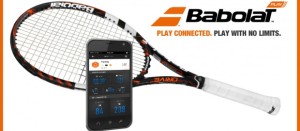In a world that seems to be dominated by activity trackers (think Fitbit or Jawbone), it is not surprising that Babolat has just announced the Babolat Play, their very own activity-tracking tennis racket. The company revealed the fancy technology during the French Open when they publically displayed Rafael Nadal’s statistics on the jumbo screen after his first round win against Quentin Halys.
So, what is it we are actually working with here? What exactly is this racket tracking? For starters, the highly connected racket can distinguish between and record how many serves, forehands, backhands, etc. that a player hits during a session or a match. While this is cool, I would argue that if the perks of the technology ended with that, the tracking racket would prove to be fairly useless. I know that, if things are going my way, I hit more forehands than backhands. I can tell you that about my game playing with my regular dumbed down racket. Fortunately, the Babolat Play doesn’t stop there. More interestingly, the racket records the type and amount of action that you put on the ball, where on the racket you hit the ball, and your intensity level throughout a session. These statistics can be vital for players determined to develop their game. It helps shed light on a player’s problem areas or weak spots. What is her power level, and how does it compare to others? When does he start to lose steam in a match? Is she hitting the sweetspot of her racket or is she a little off most of the time? For serious tennis players, having accurate answers to these questions is one of the most important steps to improving their tennis game.
While this is not a formal review of the Babolat Play (I unfortunately haven’t personally played with it), here is a breakdown of what I believe are a few of the pros and cons of the built-in sensor concept.
Pros:
Technology: The sensors track and record strokes, power, consistency, and endurance of your shots throughout a session. As I mentioned above, having physical evidence for some of these aspects of the shot can help to pinpoint weaknesses, which can more easily be improved upon.
Weight: The new Babolat Play rackets weigh the same as the older models. This is an important aspect, for it gives an opportunity for Babolat to market their most popular rackets with this new feature without any apparent changes to their original beloved rackets.
Connection: From what I have read, the data quickly connects through Bluetooth to the app on a smartphone. You can see all of the data during or immediately after hitting. Because it is a new concept though, the technology isn’t perfectly accurate while recording your shots. I believe that we will only see it improve though.
Battery: The battery life is 6 hours, enough for the common man (us non-Nadal/Djokovic folks) to get in a couple of sessions before recharging.
Cons:
Price: You have to pay a pretty penny right now for this technology, at least $299.00 a racket. You have to be serious about implementing it into your already established training program to justify such a price.
Brand: You have to want not just a Babolat racket, but one of the three models that they have built this technology into: the Pure Drive, the Pure Drive Lite, or the AeroPro Drive. While these are some of the brand’s most popular models, this limits the pool of immediate users. If you aren’t a fan of Babolat, you’re out of luck for now.
I have laid out my opinions on Babolat’s new Babolat Play, but you shouldn’t just take my word about the racket. Here are some excerpts from reviews by Babolat Play owners and trial testers:
Jon Levey on tennis.com: “However, these are minor, fixable flaws, and no one at Babolat is claiming upgrades won’t eventually be in order. They realize it’s a work-in-progress and there will be tweaks along the way. It was remarkably refreshing to hear them speak how they’ve ventured into uncharted tennis waters and they expect a little chop. But in the end, the game, and its participants, will all be the better for it.”
Philip Palermo on engadget.com: “Overall, the Babolat Play Pure Drive is a surprisingly robust and capable bit of connected sports equipment. At $400, though, the Play makes sense for those truly serious about improving their games or, perhaps, tennis coaches and academies looking to better monitor students. Hopefully, this is just Babolat’s first volley, a preview of things to come. I could imagine an entire line of Play variants of the company’s other offerings for those looking for a racquet with a different play style or, fingers crossed, a lower price tag.”
Peter on Amazon Review: “It showed how much better technique I had and how much greater power my shots had during my personally coached training sessions compared to casual games with friends. It was nice to look at the data after a lesson and see what made a difference and by how much.”
Fabiano Destri Lobo on Amazon Review: “The idea is great but the technology doesn’t work properly”
If you ask me, Babolat’s new racket technology has real potential. If you are a former or current junior players, you are all too familiar with the tortures of the video camera and watching yourself and your strokes in slow motion. While you may groan when your coach pulls out the camera (I know I did), you also know how valuable it is for improving and refining your game. The tracker can, like the camera, become a valuable supplement to tennis coaching and training. It can become another torture device that can help amp up your game to a whole new level. As the actual technology improves, I can only see positive things for the future of the Babolat Play and its effects on tennis.
